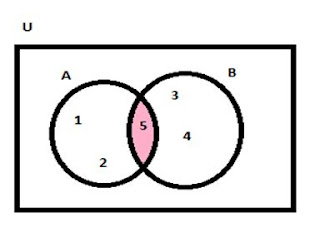Sets
In
mathematics set is defined as the collection of well defined object which can
be separated distinctly.
For
instance,
S = {2, 4,
6, 8} is collection of the even integers.
A set can
be explained in different ways:
i. Listing
method: A = {a, b, c, .z}
ii.
Descriptive method: N = {the natural numbersfrom 1 to 50}
iii. Set
builder method: A – B= A -(A∩ B )
iv. Venn –
diagram
Universal sets
A universal
set is the collection of all objects in a particular context or theory.
All other sets in that framework constitute subsets of the universal
set, which is denoted as letter U. The objects themselves are known as elements
or members of U.
Subsets
The set
made by elements of the universal sets is called subsets of the universal sets
For example
U = {1, 2,
3, 4, …………..50}
A = {even
integers from 1 to 50}
B= {odd
numbers from 1 to 50}
Here, A and
B are the subsets of U
Overlapping sets
Two sets
are said to be overlapped if they have same element in common.
A∩ B = {6}
A and B are
overlapping sets.
Disjoint sets
Two sets
are said to be disjoint sets if there is no element in common.
Cardinality of the sets
The number
of the elements in the given sets is known as cardinality of sets.
A = {1, 2,
5,}
B = {5, 3,
4}
AUB = {1,
2, 3, 4, 5}
n(A) =3
n(B) = 3
n(AUB) = 5
Cardinality of the three sets
LetA and B
and Crepresent threesets asa shown in the figure s
n(AUBUC)
=n(A) + n(B) + n(C) - n(A∩ B) -- n(B∩ C) - n(C∩ A) +n(A∩ B∩ C)
Operation of sets
Union of sets
The set
which includes elements of A and B is called union of the sets.
A = {1, 2,
5,}
B = {5, 3,
4}
AUB = {1,
2, 3, 4, 5}
Or, AUB=
{x: xϵ A orxϵ B}
n(A) =3
n(B) = 3
n(AUB) =
n(A) + n(B) - n(A∩ B)
= 3 +3 -1 =
5
Intersections of sets
If the
elements of set belongs to both Sets A and B, it is called intersection of A
and B.
A = {1, 2,
5}
B = {5, 3,
4}
A∩ B = {5}
n(A∩ B) =
n(A) – n0 (A) = 3 -2 = 1
Or, A∩ B =
{x: xϵ A and xϵ B}
Complement of sets
The set
that contains all the elements of universal sets except the given set A is
called complement of the set A . It is denoted by A̅
Difference of sets
If A and B
are the two sets , the difference of the dsets is the elements of the set thst
includes only in one set .
A – B= A
-(A∩ B )
B- A= B-(A∩
B )
Example
Examples1
In a group
of 200 students who like game, 120 like cricket game an 105 like football game.
By drawing Venn diagram find
i. how many
students like both the games ?
ii. How
many students like only cricket?
Soln
n(U) = 200
C and
F denote the students who study Cricket and football respectively.
n(C) =120
n(F) = 105
n( C ∩ F)=?
We have
n(CUF)=n(C)
+ n(F) -n(C∩ F)
200=120 +
105 -n(C∩ F)
n(C∩ F)= 25
n0(C) = n(C)-n( C ∩ F)=
120 – 25 = 95
Examples 2
In the
certain examination, 50% students passed in account, 30% passed in English, 30%
failed in both and 25 student passes in both subjects. By drawing Venn –
diagram, find the number of the students who passes in account only.
Let total
number be x A and E denotes the students who study account and English
respectively
n(A) =50%
n(E) = 30%
n( A U E)c = 30%
n( A U E) =
25
We have
n(U)= n(A)+ n(E)+ - n( A ∩E)
100%= 50 %
+ 30% + 30 % - n( A ∩E)
n( A ∩E) =
10%
According
to the question,
10% of x =
25
x= 250
The number
of the students who passed in accounts only = 40% of the 250 = 100
Examples 3
In a
survey it was found that 8.%people like oranges ,85% like mangoes and 75% like
both But 45 people like none of themDrawing Venn –diagram , find the number of
the people whowere in the survey.
Soln:
Let O and M
be the number of people who like oranges and mangoes respectively.
n (U) =n(OUM) +
100%=n (O) + n (M) - n(O∩M) +
100% =80% + 85% - 75% +
= 10%
According
to the question,
10%of total
number(say x)= 45
Or, x= = 450






















yes it is helpful
ReplyDeleteI need this app
ReplyDelete